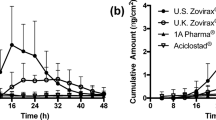Abstract
Purpose
To compare the sensitivity of a pharmacokinetic assay, the in vitro permeation test (IVPT), with that of a pharmacodynamic assay, the human skin blanching or vasoconstrictor (VC) assay, in assessing the relative bioavailability of topical clobetasol propionate products.
Methods
The percutaneous absorption of clobetasol propionate from five commercial products was measured in vitro using cryopreserved human skin. The pharmacodynamic potency of the same five products was also assessed in vivo using the VC assay, the surrogate method by which regulatory authorities in the United States establish the bioequivalence of generic topical glucocorticoid products.
Results
IVPT found total clobetasol absorption varying ten-fold from highest to lowest product, whereas the VC assay found this same difference was less than two-fold. The coefficient of variation ranged from 78 to 126% in the VC assay, but only 30–43% for IVPT. Statistically, IVPT could separate the 5 products into three groups: 1) ointment, 2) cream and gel, 3) emollient cream and solution). Due to its greater variability as well as saturation of the pharmacodynamic response at higher flux levels, the VC assay found all products except the solution to be equipotent.
Conclusions
IVPT was found to be substantially more sensitive and less variable than the VC assay for assessing clobetasol bioavailability.




Similar content being viewed by others
References
Franz TJ, Lehman PA, Raney SG. The cadaver skin absorption model and the drug development process. Pharmacopeial Forum. 2008;34(5):1349–56.
Skelly JP, Shah VP, Maibach HI, Guy RH, Wester RC, Flynn G, et al. FDA and AAPS report of the workshop on principles and practices of in vitro percutaneous penetration studies: relevance to bioavailability and bioequivalence. Pharm Res. 1987;4(3):265–7.
Lehman PA, Raney SG, Franz TJ. Percutaneous absorption in man: in vitro-in vivo correlation. Skin Pharmacol Physiol. 2011;24(4):224–30.
Franz TJ, Lehman PA, Raney SG. Use of excised human skin to assess the bioequivalence of topical products. Skin Pharmacol Physiol. 2009;22(5):276–86.
Franz TJ, Parsell DA, Halualani RM, Hannigan JF, Kalbach JP, Harkonen WS. Betamethasone valerate foam 0.12%: a novel vehicle with enhanced delivery and efficacy. Int J Dermatol. 1999;38(8):628–32.
McKenzie AW, Stoughton RB. Methods for comparing percutaneous absorption of steroids. Arch Dermatol. 1962;86:608–10.
US FDA. Guidance for Industry, Topical Dermatologic Corticosteroids: In Vivo Bioequivalence. VC Guidance. Center for Drug Evaluation and Research, Rockville, MD1995.
Games PA, Howell JF. Pairwise multiple comparison procedures with unequal n’s and/or variances: a Monte Carlo study. J Educ Stat. 1976;1:113–25.
US FDA. Approval Package, ANDA 75–430, Clobetasol Propionate Emollient Cream 0.05%. Bioequivalence Review. Center for Drug Evaluation and Research, Rockville, MD http://www.accessdata.fda.gov/drugsatfda_docs/nda/99/75-430_clobetasol.cfm
US FDA. Approval Package, ANDA 75–279, Clobetasol Propionate Gel 0.05%. Bioequivalence Review. Center for Drug Evaluation and Research, Rockville, MD http://www.accessdata.fda.gov/drugsatfda_docs/anda/99/075279_clobetasol_toc.cfm
US FDA. Approval Package, ANDA 75–633, Clobetasol Propionate Emollient Cream 0.05%. Bioequivalence Review. Center for Drug Evaluation and Research, Rockville, MD http://www.accessdata.fda.gov/drugsatfda_docs/anda/2001/075733_clobetasol_propionate_toc.cfm
US FDA. Approval Package, ANDA 75–733, Clobetasol Propionate Emollient Cream 0.05%. Bioequivalence Review. Center for Drug Evaluation and Research, Rockville, MD http://www.accessdata.fda.gov/drugsatfda_docs/anda/2001/075733_clobetasol_propionate_toc.cfm.
US FDA. Approval Package, ANDA 78–223, Clobetasol Propionate Lotion 0.05%. Bioequivalence Review. Center for Drug Evaluation and Research, Rockville, MD http://www.accessdata.fda.gov/drugsatfda_docs/anda/2008/078223Orig1s000.pdf
Stoughton RB, Wullich K. Relation of application time to bioactivity of a potent topical glucocorticoid formulation. J Am Acad Dermatol. 1990;22(6 Pt 1):1038–41.
Fang JY, Shen KL, Huang YB, Wu PC, Tsai YH. Evaluation of topical application of clobetasol 17-propionate from various cream bases. Drug Dev Ind Pharm. 1999;25(1):7–14.
McKenzie AW. Percutaneous absorption of steroids. Arch Dermatol. 1962;86:611–4.
Scheuplein RJ, Ross LW. Mechanism of percutaneous absorption. V. Percutaneous absorption of solvent deposited solids. J Invest Dermatol. 1974;62(4):353–60.
Franz TJ, Lehman PA. Percutaneous absorption. In: Swarbrick J, Boylan JC, editors. Encyclopedia of pharmaceutical technology. New York: Marcel Dekker; 1995. p. 413–47.
Anissimov YG, Roberts MS. Diffusion modeling of percutaneous absorption kinetics: 2. Finite vehicle volume and solvent deposited solids. J Pharm Sci. 2001;90(4):504–20.
Harding SM, Sohail S, Busse MJ. Percutaneous absorption of clobetasol propionate from novel ointment and cream formulations. Clin Exp Dermatol. 1985;10(1):13–21.
US FDA. Medical Officer’s Review of NDA19-966, Temovate (clobetasol propionate) Scalp Application 0.05%. Center for Drug Evaluation and Research, Rockville, MD http://www.fda.gov/RegulatoryInformation/FOI/HowtoMakeaFOIARequest/default.htm
US FDA. Medical Officer’s Review of NDA19-968, Ultravate (halobetasol propionate) Ointment 0.05%. Center for Drug Evaluation and Research, Rockville, MD, http://www.fda.gov/RegulatoryInformation/FOI/HowtoMakeaFOIARequest/default.htm
US FDA. Clinical Review of NDA 20–337, Temovate (clobetasol propionate) Gel 0.05%. Center for Drug Evaluation and Research, Rockville, MD. http://www.fda.gov/RegulatoryInformation/FOI/HowtoMakeaFOIARequest/default.htm
US FDA. Clinical Review of NDA 20–340, Temovate (clobetasol propionate) Emollient Cream 0.05%. Center for Drug Evalustion and Research, Rockville, MD. http://www.fda.gov/RegulatoryInformation/FOI/HowtoMakeaFOIARequest/default.htm
Physicians Desk Reference. 58 ed. Montvale, NJ: Thomson PDR; 2004.
Wiedersberg S, Naik A, Leopold CS, Guy RH. Pharmacodynamics and dermatopharmacokinetics of betamethasone 17-valerate: assessment of topical bioavailability. Br J Dermatol. 2009;160(3):676–86.
Stoughton RB. Vasoconstricto Assay - Specific Applications. In: Maibach HI, Surber C, editors. Topical Corticosteroids. Basel: S. Karger; 1992. p. 42–53.
US FDA. Summary basis of approval, NDA 20–934, Luxiq (Betamethasone Valerate) foam, clinical pharmacology and biopharmaceutics review. Rockville: Center for Drug Evaluation and Research; 1999.
Cornell RC, Stoughton RB. Correlation of the vasoconstriction assay and clinical activity in psoriasis. Arch Dermatol. 1985;121(1):63–7.
US FDA. Summary Basis of Approval, NDA 21–535, Clobex (Clobetasol Propionate) Lotion 0.05%, Clinical Pharmacology and Biopharmaceutics Review. Center for Drug Evaluation and Research, Rockville, MD http://www.accessdata.fda.gov/drugsatfda_docs/nda/2003/21-535_Clobex_BioPharmr.pdf.
Acknowledgments and Disclosures
We would like to express our appreciation to Dr. Adrian Davis for his insight and helpful comments regarding the results of this study.
Author information
Authors and Affiliations
Corresponding author
Rights and permissions
About this article
Cite this article
Lehman, P.A., Franz, T.J. Assessing Topical Bioavailability and Bioequivalence: A Comparison of the In vitro Permeation Test and the Vasoconstrictor Assay. Pharm Res 31, 3529–3537 (2014). https://doi.org/10.1007/s11095-014-1439-7
Received:
Accepted:
Published:
Issue Date:
DOI: https://doi.org/10.1007/s11095-014-1439-7




